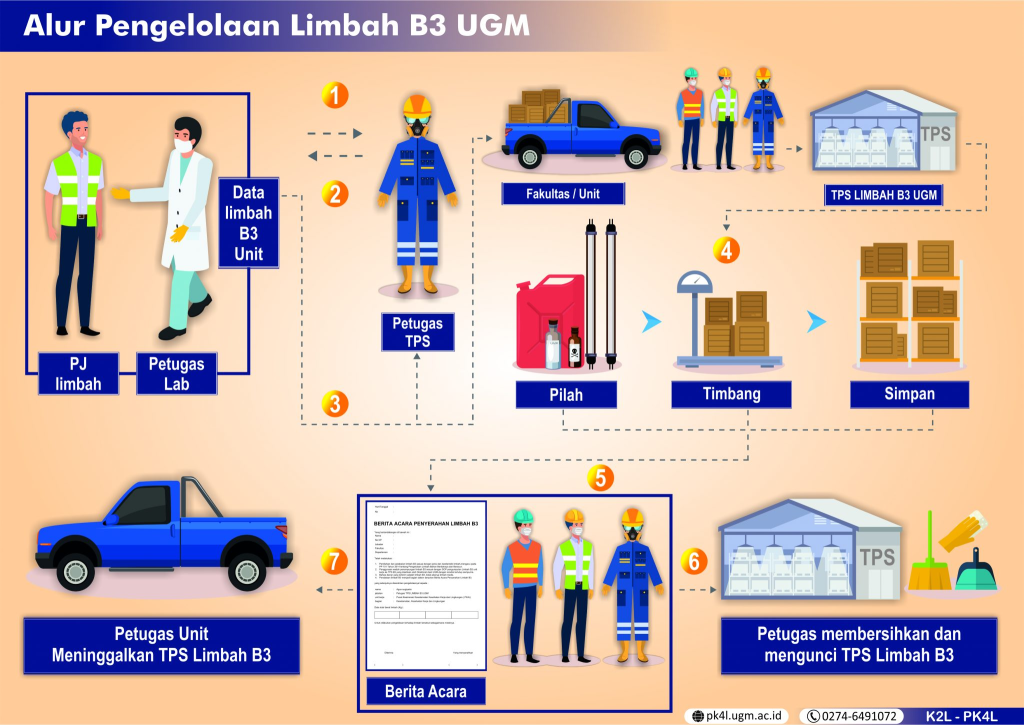Policy on hazardous waste disposal is covered in the UGM policy for all facilities, schools, and buildings to manage waste disposal based on the Circular Letter Number Rector’s Circular Letter Number 9034/UN1.P/OT.01.03/2024. Currently, a draft of the Waste Management Regulation at UGM has been submitted for review by the UGM Legal Team. This important step in the regulatory process involves a comprehensive examination of the proposed regulation to ensure its legal soundness and compliance with existing laws and regulations.
One of UGM’s notable achievements in the reduce and reuse program is exemplified by the initiatives led by the Faculty of Engineering. The Faculty of Engineering is exceptionally suited to spearhead the development and implementation of the 3R program, with a particular focus on reducing and reusing materials. As the largest faculty with a substantial student population, it has the capacity to drive significant impact. By leveraging its resources and expertise, the faculty can create a model 3R program that serves as a benchmark for success. The scale and influence of the Faculty of Engineering make it an ideal setting to pilot and refine sustainable waste management initiatives, which can then be replicated across other faculties and institutions, showcasing the potential for broader application and success.
The waste recycle efforts are centered at the Rumah Inovasi Daur Ulang (RINDU), also known as the House of Innovation for Recycling, located within the Agrotechnology Innovation Center (PIAT: Pusat Inovasi Agro Teknologi) at Universitas Gadjah Mada (UGM). As illustrated in Figure 2(c), this facility serves as a hub for recycling and waste management innovation. Additionally, as shown in Figure 2(d) and Figure 2(e), the university aims to engage and educate the academic community about organic waste processing through this initiative, fostering a culture of environmental responsibility and sustainable practices.
The waste treatment process at RINDU is part of a broader, evolving plan that will continue to be refined until 2028. Currently, the initiative has expanded to encompass multiple phases, with a long-term goal of achieving sustainability. Key components of this approach include the integration of advanced recycling processes, the involvement of technology licensors to enhance the efficiency of waste management technologies, the development of a comprehensive total solution system for waste processing, and the replication of successful models in other contexts. This initiative aligns with the principles of the reduce, reuse, recycle (3R) program, focusing on minimizing waste generation at the source, promoting the reuse of materials where possible, and efficiently recycling what remains. By educating stakeholders (either in faculties or working units level) and advancing waste treatment technologies, the program aims to reduce the overall environmental impact of waste and create a model for sustainable waste management that can be replicated in other settings, contributing to long-term environmental and economic benefits.
Special management of hazardous material is conducted through the guidance as described in the flow chart below.

Figure above is Flow Chart of Management of Toxic Hazardous Waste (B3) (Source : https://k5l.ugm.ac.id/alur-pengelolaan-limbah-b3/). As for Laboratory Waste Management procedure, it is regulated through SOP number PRM/6.03.1/LPPT 2018. A toxic waste management fully handled by PT. PRASADHA PAMUNAH LIMBAH INDUSTRI and PT Wastec International. The UGM Laboratory produces a variety of toxic waste, which is managed on-site using specialised equipment located within the Chemical Engineering Department, UGM Academic Hospital, and the Faculty of Medicine. These departments and hospitals take proactive measures to ensure that their waste treatment processes are environmentally friendly, safeguarding the ecosystem while effectively managing emissions and waste by-products.
In 2023, UGM generated a total of 169.73 tons of toxic waste. Of this, the faculties produced 23,825.54 kg of toxic waste, a significant increase from the 5,186.91 kg recorded in 2022. This rise underscores the persistent challenges associated with hazardous waste management within the university’s operations. The waste is meticulously categorised into different types, including liquid waste, solid waste, empty packaging from hazardous materials, and fluorescent lamps (TL lamps), with all categories properly documented for effective management.
References:
